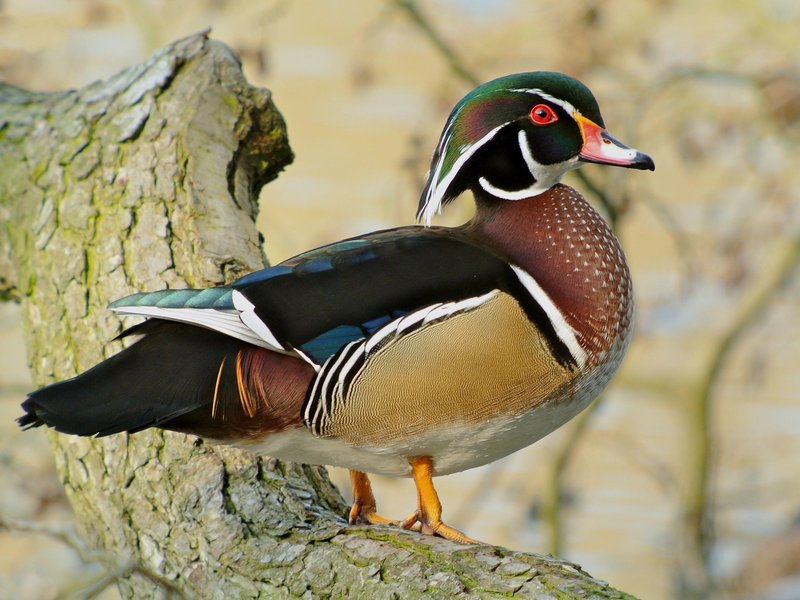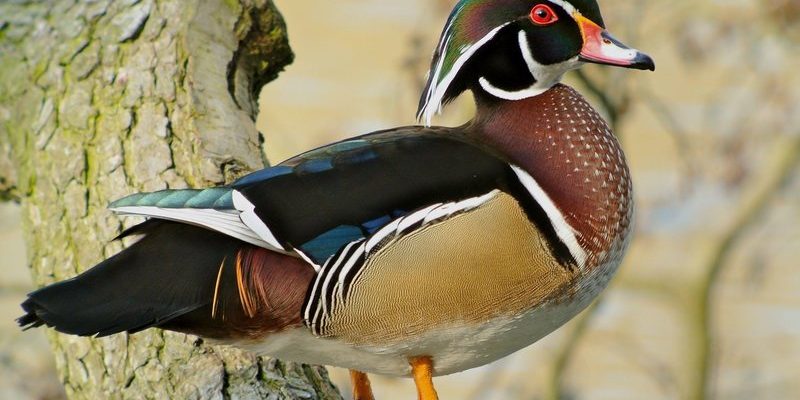
Have you ever spotted a Wood Duck gliding gracefully across a calm lake? With their vibrant colors and unique patterns, these birds are among the most stunning of North American waterfowl. Imagine a bird that looks like a moving piece of art, shimmering with iridescent greens, blues, and reds. The Wood Duck isn’t just beautiful; it also has fascinating behaviors and a unique lifestyle that sets it apart from other birds.
Native to North America, the Wood Duck is a favorite among bird watchers and nature enthusiasts. Their ability to thrive in wooded wetlands and marshes makes them a remarkable species. Whether it’s their striking appearance or their intriguing nesting habits, there’s so much to uncover about these extraordinary birds. So, let’s dive into the world of the Wood Duck and discover what makes them so special!
Characteristics of the Wood Duck
The Wood Duck is a medium-sized dabbling duck, with males and females displaying markedly different plumage. Males are adorned with spectacular colors, boasting a green head with a distinctive red eye, a white throat patch, and a chestnut breast. In contrast, females are more understated, featuring a mottled brown color with a subtle white eye-ring, which gives them a charming, gentle look.
When it comes to size, adult Wood Ducks typically measure about 18 to 21 inches in length, with a wingspan of 26 to 29 inches. This makes them slightly smaller than many other duck species. Their short, square tails and unique body shape help them maneuver expertly through their forested habitats. You might even catch them perched on tree branches, which is quite uncommon for ducks!
Their distinctive coloration serves a purpose beyond aesthetics. The bright hues of the male Wood Duck attract mates, while the female’s camouflage helps her blend into her surroundings, keeping her safe from predators, especially when nesting. This blend of striking beauty and survival strategy is just one of the many fascinating aspects of their life.
Habitat and Range
Wood Ducks are highly adaptable birds, primarily found in wooded swamps, marshes, and along lakeshores. They prefer habitats that offer both water and trees, which are essential for nesting. In fact, they are one of the few duck species that will nest in tree cavities! You can often find them in the eastern United States, parts of Canada, and even along the Pacific in California.
These ducks are particularly fond of areas with slow-moving water and dense vegetation, which provide ample food resources and shelter from predators. In the winter months, many Wood Ducks migrate south to warmer areas, though some might stay in their northern territories if the water remains unfrozen.
Interestingly, Wood Ducks are also excellent at navigating through forests. Their strong, broad wings allow them to fly swiftly between trees, making them quite agile. This ability to maneuver skillfully not only helps them escape threats but also facilitates their foraging habits, as they search for food both on water and in the surrounding vegetation.
Diet and Feeding Habits
When it comes to dining, Wood Ducks have a diverse diet that changes with the seasons. They primarily feed on seeds, fruits, and aquatic plants. You might see them dabbling on the water’s surface, tipping their bodies to reach underwater vegetation or sifting through fallen leaves on the ground in search of tasty morsels.
In warmer months, they enjoy a smorgasbord of insects and larvae, which provide the protein needed for raising their young. This adaptability to seasonal changes allows them to thrive in a variety of ecosystems. When autumn rolls around, you’ll often find them munching on acorns and seeds, making use of the abundant food supply before winter settles in.
Interestingly, Wood Ducks have a unique feeding behavior that sets them apart from other ducks. Unlike many of their aquatic counterparts, they often forage on land and in trees, using their strong legs to hop around and search for food. This ability allows them to take advantage of various food sources that may be out of reach for other waterfowl.
Nesting and Reproduction
Nesting season is an exciting time for Wood Ducks. Mating usually occurs in late winter to early spring. Males display their stunning plumage, performing elaborate courtship flights to attract females. Once paired, the female will typically select a nesting site in a nearby tree cavity or sometimes in the abandoned nests of other birds.
A single clutch can consist of 6 to 15 eggs, which are creamy white in color. The female is solely responsible for incubating the eggs, which takes about 28 to 30 days. During this period, she rarely leaves the nest, relying on her camouflage to protect her eggs from predators.
Once the eggs hatch, the ducklings are surprisingly precocial, meaning they are relatively mature and mobile shortly after birth. They leap from the nest, often from heights of over 10 feet, and immediately follow their mother to the nearest water source. It’s an astonishing sight to see these tiny ducklings make their way across the forest floor, instinctively heading toward water and safety.
Threats and Conservation
Despite their adaptability, Wood Ducks have faced several threats over the years. Habitat loss due to urban development, agriculture, and deforestation has significantly impacted their populations. Wetland degradation poses a serious threat to their breeding and feeding grounds. However, conservation efforts have made a positive impact, helping their numbers recover in many regions.
Today, various organizations work to protect Wood Duck habitats and promote awareness of their ecological importance. Nesting box programs have also been developed to provide safe nesting sites, which have proven successful in increasing their populations. These initiatives show that with concerted effort, we can make a meaningful difference in the survival of species.
Additionally, hunters and wildlife enthusiasts play a vital role in conservation. Regulated hunting seasons help manage populations and encourage the preservation of their habitats. As a result, Wood Ducks have become a symbol of successful conservation efforts in North America, reminding us that responsible management and protection of wildlife can lead to positive outcomes.
Interesting Facts about Wood Ducks
| Scientific Name: | Aix sponsa |
| Size: | 18 – 21 inches in length |
| Wingspan: | 26 – 29 inches |
| Diet: | Seeds, fruits, insects, aquatic plants |
| Lifespan: | 3 to 5 years in the wild |
| Habitat: | Wooded wetlands, marshes, lakeshores |
| Migration: | Southern migration in winter |
FAQ
Are Wood Ducks migratory birds?
Yes, Wood Ducks are indeed migratory, primarily in the northern regions of their range. As winter approaches, many will migrate south to find more favorable conditions and food sources. However, some populations in milder climates may remain in their breeding areas throughout the year.
What do baby Wood Ducks eat?
Baby Wood Ducks, or ducklings, typically start eating small insects, seeds, and aquatic plants shortly after they hatch. Their diet is essential for their growth, providing the nutrients they need to thrive in their early days. As they grow, they will expand their diet to include a broader range of food sources.
Can Wood Ducks be kept as pets?
While it might be tempting to keep a Wood Duck as a pet due to their stunning appearance, it’s important to remember that they are wild animals. They have specific habitat needs and social behaviors that are difficult to replicate in captivity. Additionally, keeping wild ducks as pets may be illegal in some areas, so it’s best to appreciate them in their natural environment.
How can I attract Wood Ducks to my backyard?
If you want to attract Wood Ducks to your property, consider adding a water feature like a pond, surrounded by native vegetation. Providing nesting boxes high in trees can also encourage them to breed in your area. Ensuring a safe and quiet environment will make your backyard more appealing to these beautiful birds.
Are Wood Ducks endangered?
No, Wood Ducks are not currently classified as endangered. In fact, their populations have rebounded over the years thanks to conservation efforts and habitat protection. However, they still face threats from habitat loss, so ongoing conservation work is important.
Do Wood Ducks make noise?
Yes, Wood Ducks are known to produce a variety of sounds. Males are usually quieter, but females are quite vocal, especially during nesting season. Their calls can include soft whistles and quacks, which help communicate with their young and signal alarm when they feel threatened.
What is the lifespan of a Wood Duck?
In the wild, Wood Ducks typically live about 3 to 5 years. However, some individuals may live longer under optimal conditions. Their lifespan can be influenced by environmental factors, food availability, and predation, all of which play a role in their survival.
How do Wood Ducks adapt to their environment?
Wood Ducks are incredibly adaptable birds. They thrive in a variety of habitats, including wooded areas, marshes, and wetlands. Their ability to feed on both aquatic and terrestrial food sources, along with their nesting behaviors, allows them to take advantage of different environments. This adaptability is key to their survival in changing landscapes.
What is a unique trait of Wood Ducks?
One unique trait of Wood Ducks is their preference for nesting in tree cavities. Unlike most ducks that nest on the ground, these birds are comfortable high in the trees, providing protection from ground predators. This nesting behavior is quite distinctive and contributes to their survival in varied habitats.
Where can I see Wood Ducks in the wild?
You can spot Wood Ducks in various locations across North America, particularly in wooded swamps, lakes, and rivers. Popular birdwatching spots include national parks and wildlife refuges where these ducks are known to breed. Early mornings and late afternoons are often the best times to observe them in their natural habitat.

